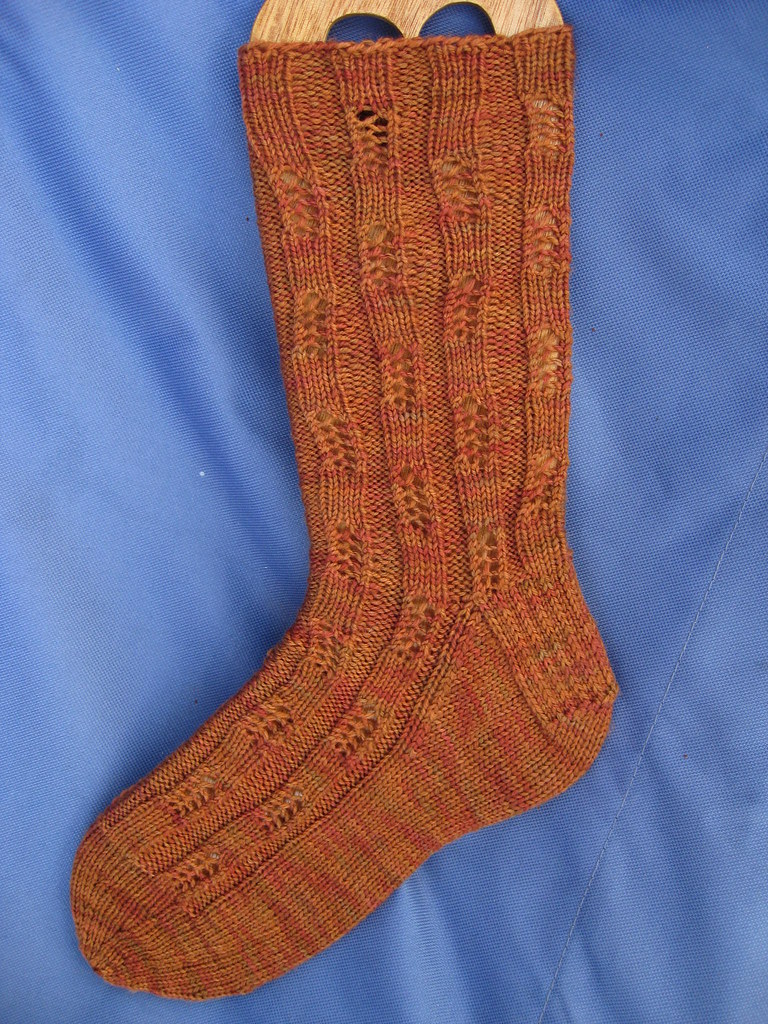 This pattern from the "Knitting Pattern A Day Calendar 2007" caught my eye because it looked like a fun approach to making stripes. I never reviewed the pattern in any detail, just noted that it instructs you to divide the work into three sections and knit each separately with a different color, dropping and picking up each color as you work around the circle. It has been magneted to my refrigerator for months.
This pattern from the "Knitting Pattern A Day Calendar 2007" caught my eye because it looked like a fun approach to making stripes. I never reviewed the pattern in any detail, just noted that it instructs you to divide the work into three sections and knit each separately with a different color, dropping and picking up each color as you work around the circle. It has been magneted to my refrigerator for months.
 It took some time to come up with adequate quantities of leftover yarn in colors that coordinated nicely. Here they are. Only one is an actual solid (the mustard yellow); another is a variegated in cream and gold, and the last is a semi-solid in light/medium brown. I decided that K5,P3 would display the colors to their best advantage and cast on. But there were problems. Two problems – one immediately obvious and one that I should have noticed long ago.
It took some time to come up with adequate quantities of leftover yarn in colors that coordinated nicely. Here they are. Only one is an actual solid (the mustard yellow); another is a variegated in cream and gold, and the last is a semi-solid in light/medium brown. I decided that K5,P3 would display the colors to their best advantage and cast on. But there were problems. Two problems – one immediately obvious and one that I should have noticed long ago.
The first problem drove me nuts for a day or two. I blame the instructions (doesn't one always?). They say to divide the sock into three roughly equal sections (for the three colors), knit with Color A until you encounter Color B, knit with color B until you encounter color C, and knit with color C until you return to Color A. This is, in fact, what you do. But after the first round, the poor knitter is left staring glumly at TWO sections and wondering what happened.
Extensive experimenting with varying quantities of colors led to the development of WoolEnough's Theory of Helix Socks, which states:
Number of Sections = Number of Colors – 1
Try it yourself. Lay out three DPN's as if to knit in the round and park a bit of yarn at each intersection. Then move the yarn around the needles as though you were knitting with it. All goes smoothly until you get to the end of the first round. There you are at the beginning of needle #1, but there is no yarn, because you left it at the end of that needle. Oops.
The division into two sections works well, though, for doing a solid heel. I began knitting the sock in the middle of the stitches designated for the heel, which resulted in one section for the heel and one for the instep. (It would have worked as well to start in the middle of the instep stitches.) When I was ready to start the heel flap I just turned and began purling back with the color I wanted to use.
Which brings us to Problem Number 2.
 The front of the pattern card contains only the technique for striping the leg and a teaser of a picture that shows a vertically striped heel flap. When I flipped the card over to get the directions for the rest of the sock, this is what I saw. Little accident at the printer's, I would guess. I checked Ravelry to see if anyone else had knit this pattern, but found only one person, who has had it "in progress" short of the heel flap for quite a while. Hmmmmm.
The front of the pattern card contains only the technique for striping the leg and a teaser of a picture that shows a vertically striped heel flap. When I flipped the card over to get the directions for the rest of the sock, this is what I saw. Little accident at the printer's, I would guess. I checked Ravelry to see if anyone else had knit this pattern, but found only one person, who has had it "in progress" short of the heel flap for quite a while. Hmmmmm.
 Here's where I am right now on the first sock. I'm running very low on brown yarn, so the toe will probably be in two colors. In spite of the initial difficulties, I really like this way of using up leftovers. And there are endless opportunities to mix solids and self-striping and multi-color yarns. Next time I'd like to figure out how to get those vertical stripes on the heel flap. I have a few ideas.
Here's where I am right now on the first sock. I'm running very low on brown yarn, so the toe will probably be in two colors. In spite of the initial difficulties, I really like this way of using up leftovers. And there are endless opportunities to mix solids and self-striping and multi-color yarns. Next time I'd like to figure out how to get those vertical stripes on the heel flap. I have a few ideas.







5 comments:
That's a good choice of colors, combined with a nice effect. I'm wondering if there is much difference between doing one-row stripes and the helix method?
For vertically striped heel, would a k1, sl1, stitch pattern, purled on the wrong side, and changing yarn every two rows work?
Wow, the colors blend perfectly-it will look like sunshine on your feet!
That sounds like a cool way to do the striping.
Is it possible to alternate rows on the heel and just carry the unused color up the side? You'd probably have a lot of yarn on the inside, though. I'll be eager to see how you solve this!
Interesting problem with the stripes. But the sock looks great and the colors blend very well.
Re: straights vs circs, now you see why I tend to dislike circular needles. If a shawl were to be knit lengthwise, or for a triangle, You would have to use circs to hold all the stitches. Otherwise why bother? As far a s I can tell, there is nothing intrinsic in lace making that would require circular needles.
Grumperina wrote about the helix method on March 20, 2008 and following (no affiliation). The trick is, you don't stop knitting when you get back to color one; you keep on knitting until you reach the next place where there is another strand of yarn, then pick up the lowest strand and knit with it. That means that at times you knit what looks like two sections with one color. Ignore the "sections", keep knitting, it works.
Post a Comment